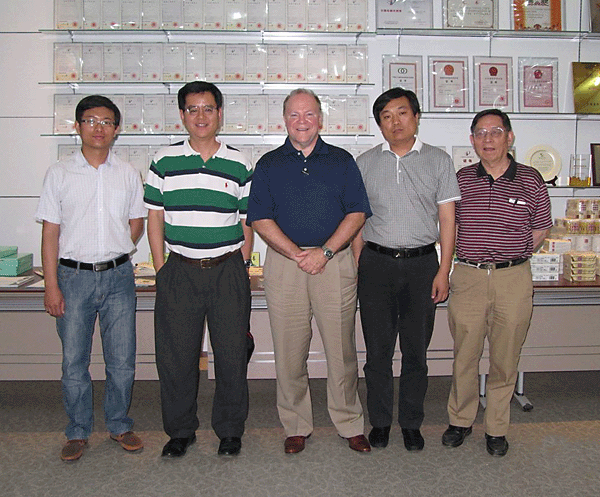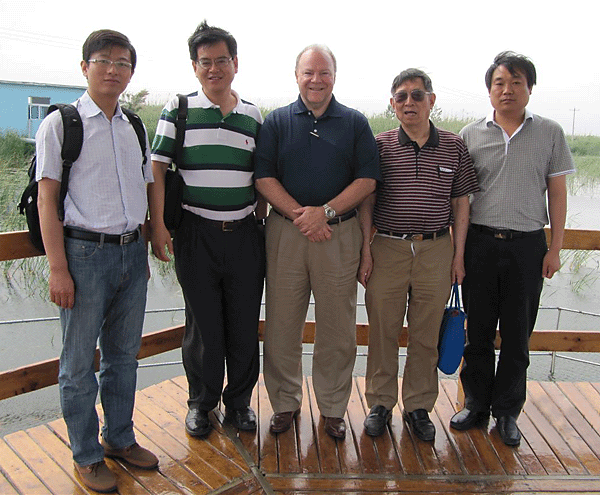
| Past Issues | TAPPI.org | Advertise | Buyers Guide | TAPPI Press Catalog Travels with Larry Archive |
The Year of the Dragon—the First in a Series of Stories About My Visit to China.
Back in 1991, during my days with Republic Paperboard in Hutchinson, Kan., USA, a gentleman set up an appointment with me to discuss a "revolutionary idea for our mill to utilize a new feedstock that was abundant in the treeless state of Kansas." I informed him that we were a recycled mill and did not use trees as a feedstock, but to come over to my office anyway to talk. During our meeting, he showed me his idea of using wheat straw as the base feedstock to make recycled paperboard. I thought it was a novel idea and I would discuss this concept with our mill team. As most folks in our industry at that time, our team said are you nuts? This will never work. What was the guy smoking? I then bowed my head and went back to the safe confines at my corporate office. Now fast forward some 21 years later. Let me set the stage. A mill is using wheat straw that used to be burned in the fields (creating pollution in the air). The straw is being used almost exclusively in the mill's tissue and printing paper machines at SHANDONG TRALIN PAPER CO., LTD. located in Shandong, China. TAPPI Fellow Michael Sun organized my trip to China. He especially wanted me to see the process and the effluent water that comes out of this mill. The COD discharge is less than 30 milligrams per liter, which beats the national China standard of 100 milligrams per liter. Our gracious hosts, for this mill visit, were Chen Songtao, chief senior engineer, and Yang Ji Hui, vice general manager of production. History. The mill is located on 2,000 acres and employs approximately 6,000 workers. It started up in 1975 and was nearly closed down in 2000 due to environmental issues. Mill management had a choice to make—either go green or shut down. And as they say..."the rest is history." They reasoned that "developed countries use wood to make paper. We don't have much wood so we have to use something else. In this case, we chose wheat straw." This solved many issues that had historically been associated with leaving wheat straw in the fields after harvest, such as insect issues, pollution from burning the fields, and 800 million tons per year of agricultural waste. Raw Materials. Annually, the mill collects 1.5 million tons of wheat straw that contains approximately 1.2 million tons of usable material, which then yields 600,000 tons of paper. In addition, they also purchase between 100,000 and 150,000 tons of softwood market pulp. Turn Around. The mill has done such a good job with this process that the Chinese government has taken notice to the tune of approving its printing and writing paper (made on the P&W paper machine) for school text books. Their paper products were also selected to be used at the 2011 Shanghai World Expo.
Our group pictured in front of a display of some of the products and awards that they have received. The Future. By 2015 the government wants the mill to expand wheat straw usage to 2 - 2.5 million tons per year. This should become a reality after Shandong Tralin Paper's million dollar expansion project is completed. The China Agriculture Department's National Reform & Development Committee is encouraging the mill to help ease pollution from the wheat straw still being burned, and to create more jobs. Sustainability. Within a 500 kilometer area around the mill, there is an estimated 23.8 million tons of wheat straw available for collection. Currently, less than 20% is being collected for all uses. Shandong Tralin Paper reports that 1 acre of planted wheat yields 1.2 tons of wheat straw. Digesters. Rather than working with continuous digesters, the mill chose to go with a system of 64 batch digesters and control system. The benefits of this system include a reduced environmental footprint and improved access to raw materials. These non-wood based products can compete with high end tissue. Product Lines. In addition to tissue and towel grades, the mill also manufactures printing and writing grades as well as molded pulp. Full Circle. Production of all products from this mill totals 700,000 metric tons per year. Any black liquor generated is dried and granulized and sold as fertilizer for plants and crops.
Left to right: Tian Chao, Michael Sun, Larry Montague, Chen Songtao, Yang Ji Hui. More information about this company that is doing something that others have stated could not be done is available online. More information about TAPPI is also available online. There are two types of people in our industry: TAPPI members and those who should be. Until next time....
|




